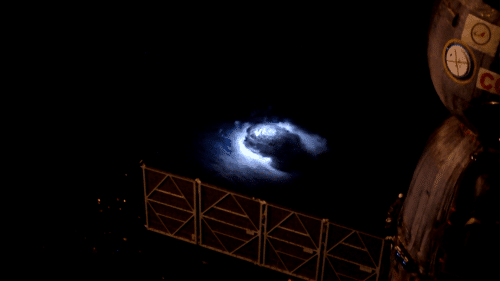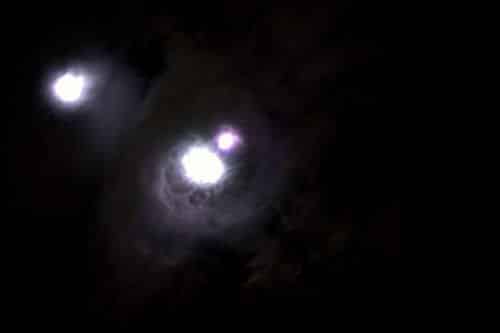Pulsating electrical discharges, flickering red sprites and blue jets - this is what was captured on the camera lens of the International Space Station as it passed over a lightning storm in the Indian Ocean. The Israeli scientist who took part in planning the mission explains what exactly happened there.

By Lior Mammon, Angle - news agency for science and the environment
When Andras Morgensen, the first Danish astronaut, was sent to the International Space Station in 2015, he could not have predicted what would be captured by his camera lens. In fact, no one could have predicted the show of blue electrical discharges that were later described by various scientists and reporters as "dancing, pulsating, flickering and elusive". As he hovers high above a lightning storm, and in a combination of Red elves and blue jets, Morgensen seems to have stumbled upon this year's disco.
Morgensen's photographs are actually the first documentation of its kind of "pulsating" electrical discharges at the peak of lightning storms, an atmospheric phenomenon that was previously unknown. The Danish astronaut got a rare opportunity to watch the show from the International Space Station, passing over a lightning storm that occurred in the Bay of Bengal, in the northeastern part of the Indian Ocean. The observations were made as part of the Thor experiment, named after the mythological Norse god of lightning and thunder, and designed to gather information about electrical processes that occur in lightning storms and the atmosphere above them. The experiment combined information collected from the space station along with data from meteorological satellites, radars and ground-based lightning tracking systems.
High lightning activity
The electrical discharges recorded from the space station are similar to the lightning that we see every winter and which are created as a result of the discharge of static electricity that accumulates at the bottom of storm clouds to the ground. The existence of lightning in storm clouds has been known since the beginning of the twenties of the last century, but they were first documented only in 1989.
One of the types of electrical discharges recorded at that time are "blue jets" - an electrical discharge projected in the form of a narrow cone from the upper part of the cloud upwards, to the upper layers of the atmosphere at an altitude of 50-40 kilometers. The origin of the blue color is in ultraviolet emissions of ionized nitrogen molecules, that is: charged with an electric charge. The discharge of the electric charge at altitude takes place between a layer charged with a positive charge in the center of the cloud, and a layer charged with a negative charge at its peak. The polarization of the layers is created by strong air currents, which contribute to high lightning activity.
https://www.youtube.com/watch?v=zC87ScAVJio
The peak of lightning storms is in high layers of the atmosphere, and is not accessible for conducting experiments and observations. As a result, our knowledge of the processes occurring there is limited, incomplete, and largely based on laboratory experiments and simulations. In addition, photographic documentation of the top of the cloud requires the astronaut to be in the right place at the right time, and with the right camera. The observations obtained in this experiment are particularly spectacular thanks to the successful combination of a color, light-sensitive and high-resolution camera, the high intensity of the storm's electrical discharge and the precise viewing angle from which Morgensen photographed, in the short window of opportunity allotted to him when he passed over the location of the storm.
But the stars didn't just align for the Danish astronaut. Prof. Yoav Yair, Dean of the School of Sustainability at the Interdisciplinary Center Herzliya, was one of the developers of the technique that made it possible to predict the exact location of the storm, the time window for observations during the passage of the International Space Station above it, and the appropriate camera angles for ideal photography of the storm. In fact, the global forecasting method developed by Yair for finding the centers of large thunderstorms in order to capture lightning sprites has already been tried in the past, in the Madex experiment of the Columbia expedition, whose participants included the late Israeli astronaut Ilan Ramon.
According to Prof. Yair, even then the experiment produced interesting results that led the Japanese delegation in 2013 and the Danish delegation in 2015 to contact him with a request to reproduce the experiment a second time. Although, photography from the space station allows coverage of a large area, but the window of time in which you can take photos is limited, so the moment when the space station will pass over the storm, the focus of the storm, and the angles that will provide maximum information must be coordinated with great precision. The lightning storm over the Bay of Bengal was predicted three days in advance, but the prediction mechanism developed by Yair was accurate up to the window level from which Morgensen would see the lightning in the best way. Morgensen had ten minutes to photograph the storm, and he even floated to the cupola, the station's large observation window, to get a "closer" view.
In the photographed materials it is possible to distinguish, among other things, red lightning sprites and blue jets, two known electro-optical phenomena that occur above lightning storms. But to the scientists' surprise, another phenomenon was observed that had never been recorded before - elusive blue flickers at the top of the cloud, for which a catchy name has not yet been found. Since these flickers only occur at the top of the cloud, the only possibility to observe them is with aerial observations. Their "flickering" feature is probably due to short and fast electrical discharges compared to the blue jets. The successful documentation is also largely due to the technological development of photography equipment since 2003.
A happy closing of the circle
"The exciting part of the experiment is that it was not possible to predict the new phenomena discovered in its reconstruction," says Yair, who sees this as a kind of happy closing of the circle with the Madex experiment. The photographs revealed a surprising variety of shows of electrical activity in and above lightning storms, including the first documentation of the pulsating electrical discharges at their peak.

In the article Published in January 2017, with Yair among its authors, it concludes that it is now up to scientists to try to understand the possible consequences of this phenomenon on atmospheric chemistry. The electrical discharges occur at the boundary between the troposphere, the lower layer of the atmosphere, which starts at ground level and reaches a height of 20-17 kilometers, to the stratosphere layer, which is defined at a height between 17 and 50 kilometers, and in which the temperature rises as you go up in height - this is in contrast to what we know from the surface of the ground (In the stratosphere, by the way, is the ozone layer).
The lightning storm clouds rising to a height of about 18 kilometers above the ground, combined with the emissions of the blue jets projected up to a height of about 40 kilometers, contribute to the exchange of greenhouse gases between the two layers. Therefore, the scientists estimate that together with additional interactions between the stratosphere and the troposphere, the discharges may affect the total radiation balance of the Earth.
The radiation balance, which weighs the total incoming solar energy with the total energy returned to space, depends on many factors, including the distance of the Earth from the Sun, the ground cover and the composition of the atmosphere. When the amount of incoming radiation is balanced with the amount of reflected radiation, it can be said that the Earth is in equilibrium, and that the global temperature remains constant. When the radiative equilibrium is violated, such as following changes in the percentage of greenhouse gases in the atmosphere as a result of electrical discharges in lightning storms, the temperature of the earth may change accordingly. The information gathered in the experiment during which the new phenomena were recorded may, therefore, help to better understand the processes affecting the radiation balance.
